Ten years ago I installed an Ikea Digniet wire in our dining room to provide a place to “hang my collection of ephemera.” When we got the dining room painted a few years ago, it got taken down, the wall repaired, and the ephemera went back into the archive.
But I saved the wire, and today Lisa and I hung it back up, this time in our front hallway:
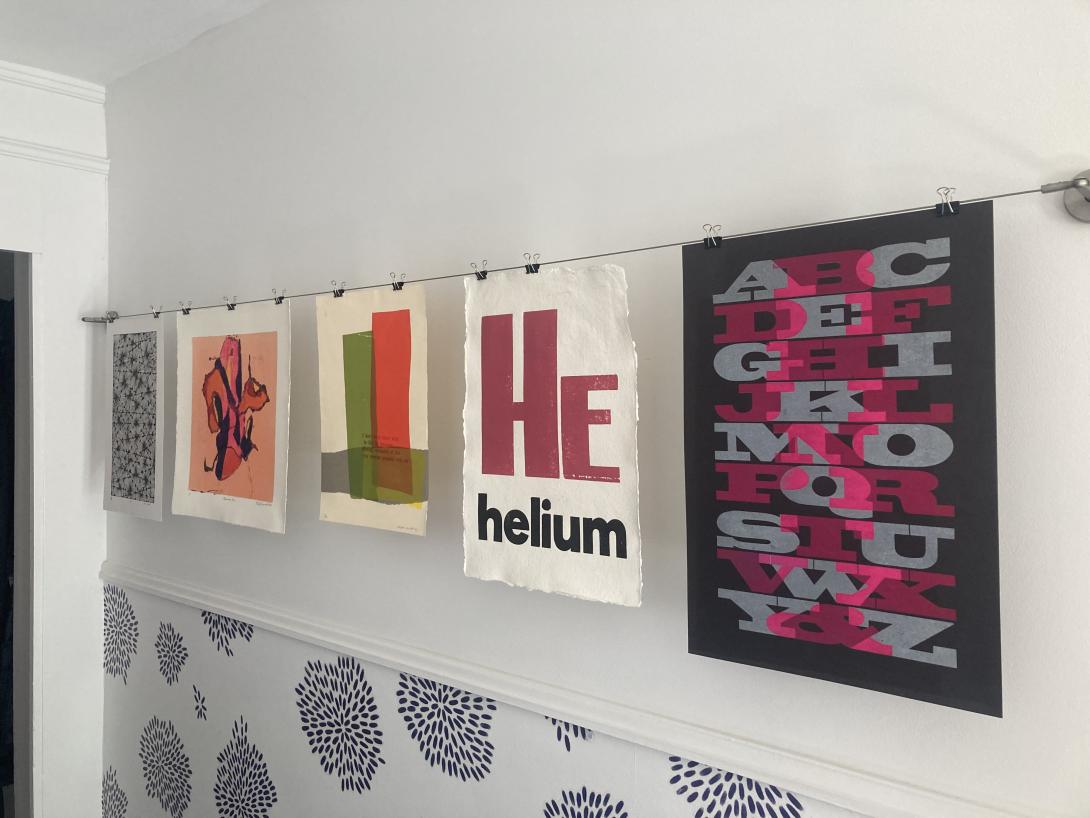
From left to right, the pieces we’ve hung to start:
- A whimsical and very detailed drawing by Halifax artist Bruce Roosen.
- A bright, colourful monotype from Lisa’s recent experimenting in the print shop.
- A print I found in my archives from the late artist Sandy Hunter, a friend from my Peterborough days.
- An experiment in printing with wooden type that I printed in Serrazzano last spring.
- A colourful alphabet-on-black that surely must have come from Jackson Creek Press.
Meanwhile, around the corner at the bottom of the stairs, Lisa hung a framed version of my Furiously Curious print, using an inexpensive red frame from Ikea that complements it well:
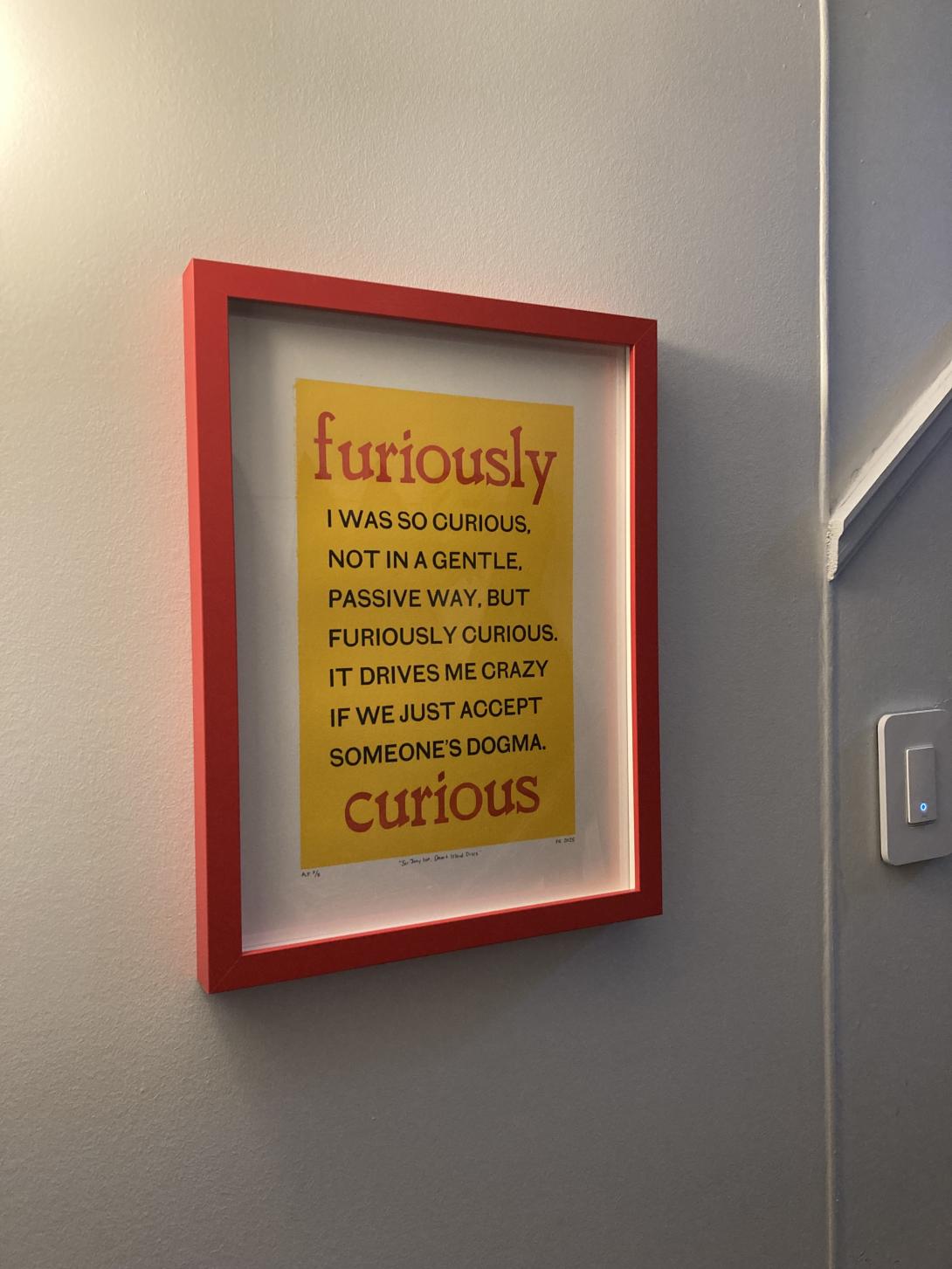
And, while we were on an art-roll, Lisa suggested we retrieve a large painting from storage and use it to fill up a large empty space on our kitchen wall:
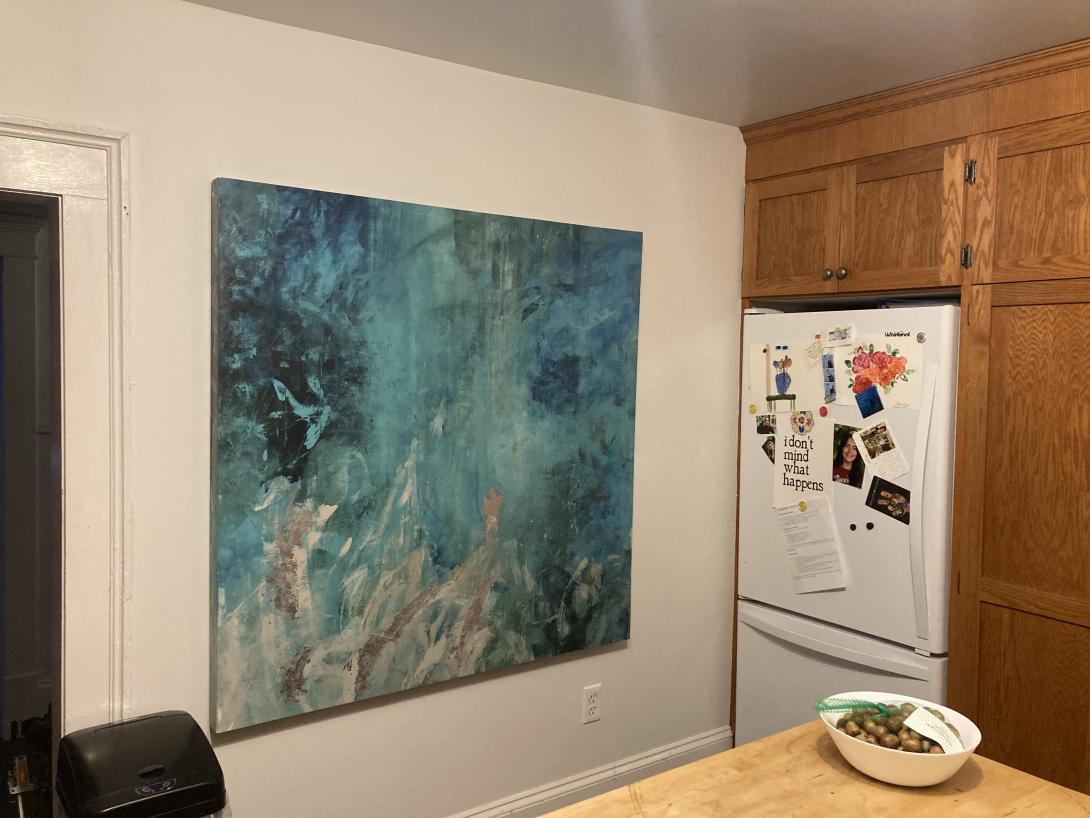
Behind all three of these hangings were slight eruptions of internal discomfort that I needed to quell.
I don’t like drilling holes into walls (it seems so permanent).
I don’t like that the fridge door can slam into the kitchen artwork.
That the front door opening can rustle the art-on-a-wire makes me nervous.
But what trumps those discomforts are the inarguable facts that they improve our living space significantly, and they allow us a place to see our own work, and those of our friends and familiars, out in the open.
(Lisa wrote a post—a much better one—about the same thing!)
Spotted in my friend Shannon’s bathroom in Kingston earlier this week:
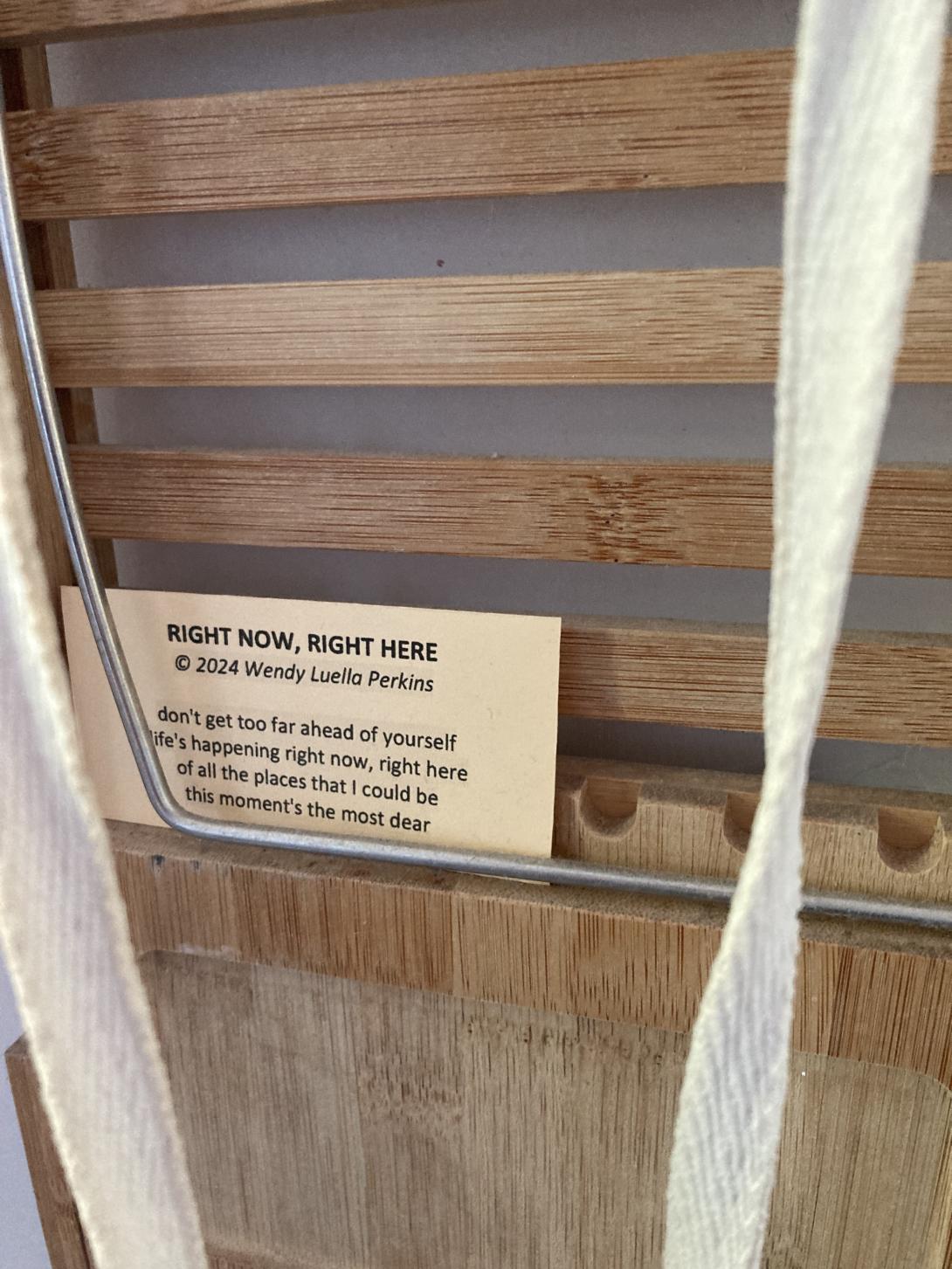
Wendy Luella officiated at my friend Stephen’s mother Carol’s funeral.
That conference—and those that followed in 2006, 2007, 2008, and 2009—changed are changing my life, in ways that I continue to discover.
Some of that change was obvious at the time.
In reflecting on the closing day—exactly 20 years ago— I wrote, in Shy:
And of course I’m just plain afraid. Terrified of the unknown, suddenly left frozen at the thought of freeform social contact.
Given that the interesting part of conferences happens during the “hanging out in the coffee room after the speakers” part, this fear / awkwardness / terror leaves me at something of a disadvantage.
Halfway through reboot, I decided that, fuck it, I had to just jump off. Pretend I wasn’t terrified, and see what played out.
(It worked.)
In other ways I’m only now able to understand why reboot was so important, what role it played in my life, how it saved my life.
Reboot was my gateway to cultivating a love of Europe, an easy facility with Europe, and a network of European friends. Denmark, Sweden, Germany, The Netherlands, Portugal, Italy, and the friends thereof, have proved a wellspring of ideas, inspirations, opportunities, connection.
What a privilege it is to have a magic place to go, long over the horizon and far away from the everyday, that serves as a kind of off-site for mind, body, and soul.
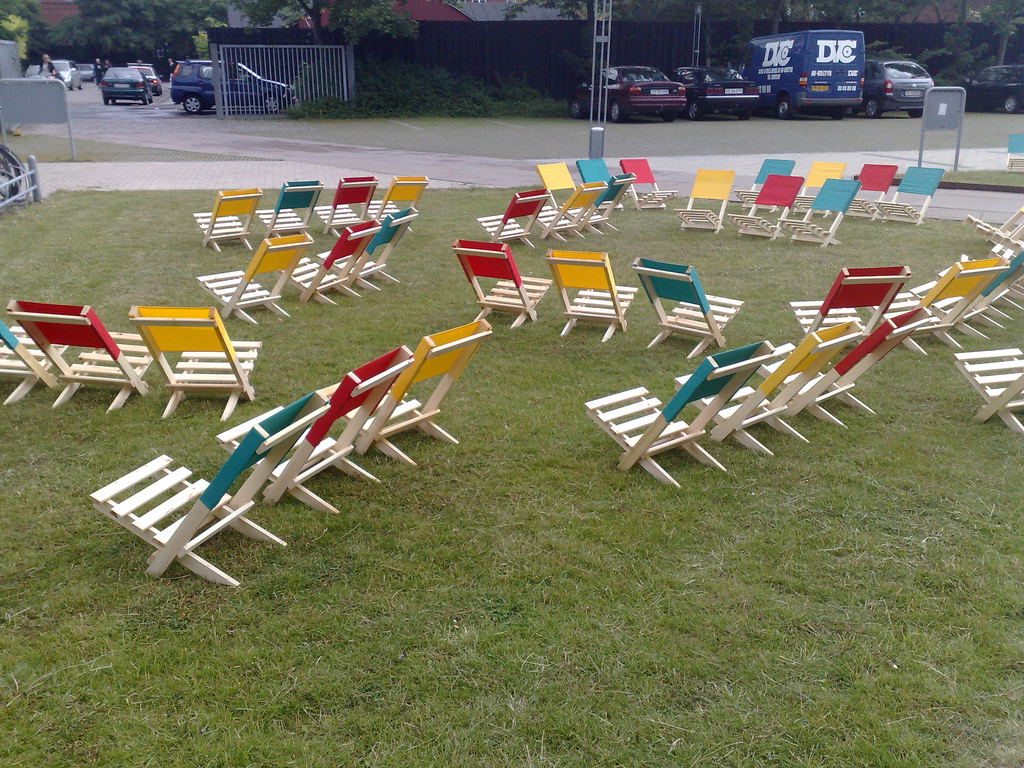
But time has shown me more.
In recent months I’ve been working with a counsellor schooled in the ways of Internal Family Systems, and through that practice I’m becoming more aware of what IFS calls my “self” and my “parts.” And through that, I’m starting to learn more about how elusive my “self” has been, for a long, long time.
IFS associates “self-leadership” with “eight Cs”:
It is also a way of understanding personal and intimate relationships and stepping into life with the 8 Cs: confidence, calm, compassion, courage, creativity, clarity, curiosity, and connectedness.
Those are all qualities that, to one degree or another, have been absent from my life, obscured behind a thicket of parts—fear, anger, loneliness, overwhelm, disconnectedness, shame, avoidance. One of the great gifts of plucking up my courage to go to that first reboot conference, and the opportunities that followed from it, is that I was gifted a glimpse of “self,” a creative, courageous, curious version of myself.
I love that guy, and it’s no wonder that I was, and am, drawn to Europe to rekindle my relationship with him.
So, yes, reboot saved my life, let me connect to myself.
But it also delayed my life, stunted it.
By rooting access to “self” off-shore, I remained content, or at least resigned, to allow my everyday life at home to be “parts-led.”
Historically, I felt this most acutely on the transitions back to home from Europe, where it felt like a fog descending over me, like going through a glitchy version of the Star Trek transporter that filtered out access to some important parts of myself.
This is difficult to write about, in part because it appears that I’m throwing a huge swath of my life under the bus, a swath rooted in a partner who died, a child I’m continuing to raise, myriad work and volunteer projects and relationships.
I don’t want to suggest that my life has sucked, with brief respites when it didn’t, because that’s both not true, and over-simplifies the ever-changing presence of “parts” and “self” in my life.
But I do find myself understanding how much I have been holding in for so long, how shallow I’ve allowed my relationships to be, how I’ve used fear as a guard against vulnerability.
Pete Livingstone—who I met in Copenhagen many years ago, another byproduct of my reboot life—wrote this, in a blow-by-blow of his 2024 cancer treatment:
On the other hand I can now concede that being pushed towards an awareness of ones own mortality – coupled with a degree of illness and physical discomfort - may have some weird and unexpected effects on ones unconscious mind. In my case it feels like that the experience I have gone through has conferred on my body and mind an ability to perform, on occasion, what I want to describe as an “action”, a kind of psychic, almost physiological muscle-flexing. This “action” feels completely novel to me, but I can feel that the potential to carry it out has always lain dormant inside me, and indeed is part of how I, and I presume all other humans, are put together. It’s as if, quite sensibly, we contain an algorithm in our unconscious which lies in wait, and is specifically for dealing with suffering and death. The tentative flexing of this previously unused psychic muscle seems to set off some emotional events which I find unfamiliar in an almost alarming way.
Perhaps you could describe what Pete experienced as a “reboot,” and perhaps I could, now that I think of it, describe my life in recent years in the same way.
Like reboot the conference gifted me a taste of “self,” going through years of life as a carer, living through the death of my partner of 28 years, nurturing Olivia through COVID, finding new love in an audacious partner (and an audacious step-daughter), leaving paid work and reimagining myself as a printer, helping set Olivia off toward independence, all of that was a portal, its own kind of reboot, that, having emerged, somewhat intact, out the other side, allows me slightly more clarity, more access to my parts and my self and how I have lived, and will live my life.
When I reflected on that first reboot 15 years ago, on its 10th anniversary, I wrote:
On June 14, I flew back to Prince Edward Island, via Frankfurt and Montreal. Exhausted but happy and very, very changed.
That’s not a bad way of describing my current state: exhausted but happy and very, very changed.
Thank you, reboot.
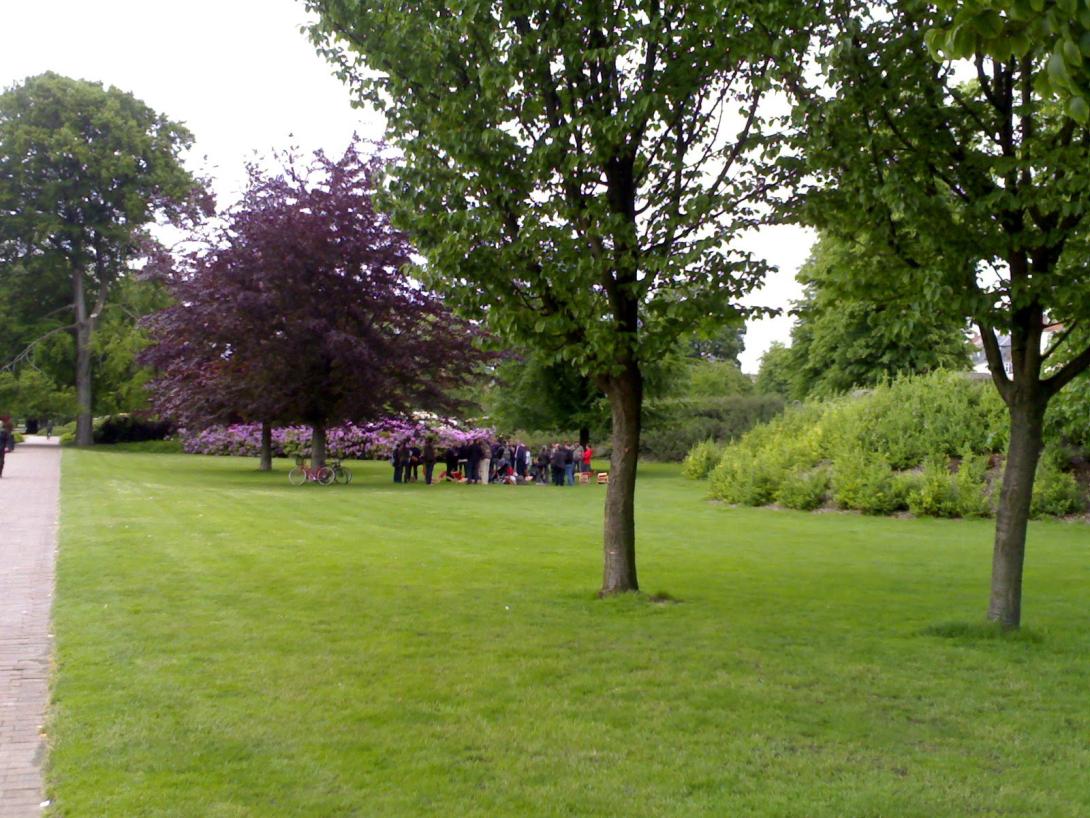
Since I migrated this blog to a Hetzner server, I’ve been paying attention to the “Graphs” tab of the server dashboard to see how the capacity of the server matches the traffic I’m expecting it to handle.
One of the things I’ve noticed is that there are regular periods of very high CPU usage, periods where the 4 vCPUs are almost maxed out:

These periods are accompanied by corresponding jumps in network traffic:

I got curious about what might be causing this, and, because I suspected web traffic bumps, I started by looking at the 20 most popular user-agents in my Apache logfiles, with:
awk -F'"' '{print $6}' access.log | sort | uniq -c | sort -nr | head -20The result:
577651 Scrapy/2.11.2 (+https://scrapy.org)
39018 Mozilla/5.0 (Linux; Android 5.0) AppleWebKit/537.36 (KHTML, like Gecko) Mobile Safari/537.36 (compatible; Bytespider; spider-feedback@bytedance.com)
23216 Mozilla/5.0 (iPhone; CPU iPhone OS 18_5 like Mac OS X) AppleWebKit/605.1.15 (KHTML, like Gecko) Version/18.5 Mobile/15E148 Safari/604.1
15561 Mozilla/5.0 (X11; Linux x86_64) AppleWebKit/537.36 (KHTML, like Gecko) Chrome/117.0.0.0 Safari/537.36
14793 Mozilla/5.0 AppleWebKit/537.36 (KHTML, like Gecko; compatible; GPTBot/1.2; +https://openai.com/gptbot)
14571 Mozilla/5.0 (Windows NT 10.0; Win64; x64) AppleWebKit/537.36 (KHTML, like Gecko) Chrome/137.0.0.0 Safari/537.36
12838 Mozilla/5.0 (Linux; Android 10; K) AppleWebKit/537.36 (KHTML, like Gecko) Chrome/137.0.0.0 Mobile Safari/537.36
12306 Mozilla/5.0 (compatible; SemrushBot/7~bl; +http://www.semrush.com/bot.html)
10834 Mozilla/5.0 (Macintosh; Intel Mac OS X 10_15_7) AppleWebKit/605.1.15 (KHTML, like Gecko) Version/18.5 Safari/605.1.15
9714 Mozilla/5.0 AppleWebKit/537.36 (KHTML, like Gecko; compatible; ClaudeBot/1.0; +claudebot@anthropic.com)
7104 Mozilla/5.0 AppleWebKit/537.36 (KHTML, like Gecko; compatible; Amazonbot/0.1; +https://developer.amazon.com/support/amazonbot) Chrome/119.0.6045.214 Safari/537.36
7005 Mozilla/5.0 AppleWebKit/537.36 (KHTML, like Gecko; compatible; bingbot/2.0; +http://www.bing.com/bingbot.htm) Chrome/116.0.1938.76 Safari/537.36
6287 Wget/1.21.3
5885 meta-externalagent/1.1 (+https://developers.facebook.com/docs/sharing/webmasters/crawler)
5093 Mozilla/5.0 (Windows NT 10.0; Win64; x64; rv:139.0) Gecko/20100101 Firefox/139.0
4798 Mozilla/5.0 (Linux; Android 6.0.1; Nexus 5X Build/MMB29P) AppleWebKit/537.36 (KHTML, like Gecko) Chrome/137.0.7151.68 Mobile Safari/537.36 (compatible; Googlebot/2.1; +http://www.google.com/bot.html)
4593 Mozilla/5.0 (Windows NT 10.0; Win64; x64) AppleWebKit/537.36 (KHTML, like Gecko) Chrome/91.0.4472.124 Safari/537.36
4143 Mozilla/5.0 (Macintosh; Intel Mac OS X 10_15_7) AppleWebKit/537.36 (KHTML, like Gecko) Chrome/137.0.0.0 Safari/537.36
3446 -
3228 Mozilla/5.0 (X11; Ubuntu; Linux x86_64; rv:72.0) Gecko/20100101 Firefox/72.0I asked ChatGPT to normalize and summarize, which gave me:
| Lines | Normalized User-Agent | Type | Notes |
|---|---|---|---|
| 577651 | Scrapy | Bot | Likely automated scraping (Scrapy framework) |
| 39043 | Bytespider | Bot | From ByteDance (TikTok); known aggressive crawler |
| 23337 | Safari on iPhone | Browser | Human traffic, Apple mobile Safari |
| 15590 | Chrome on Linux | Browser | Human or automation (generic Linux desktop Chrome) |
| 14793 | GPTBot | Bot | OpenAI’s web crawler |
| 14571 | Chrome on Windows | Browser | Human or automation (Windows desktop Chrome) |
| 12838 | Chrome on Android | Browser | Human traffic, mobile Chrome |
| 12307 | SemrushBot | Bot | SEO bot from Semrush |
| 10840 | Safari on macOS | Browser | Human traffic |
| 9727 | ClaudeBot | Bot | From Anthropic (AI crawler) |
| 7105 | Amazonbot | Bot | Amazon’s crawler |
| 7018 | Bingbot | Bot | Microsoft’s search indexer |
| 6296 | Wget | Tool | Scripted fetch tool; likely automation or scraping |
| 5891 | Facebook External Agent | Bot | Facebook link preview/crawler bot |
| 5101 | Firefox on Windows | Browser | Human traffic |
| 4798 | Googlebot on Android | Bot | Google’s search bot, disguised as Android browser |
| 4593 | Chrome on Windows | Browser | Redundant with earlier Chrome/Windows |
| 4143 | Chrome on macOS | Browser | Human or automation, Mac desktop |
| 3447 | Unknown (“-”) | Unknown | Empty/missing user-agent |
| 3231 | Firefox on Linux (Ubuntu) | Browser | Human traffic |
It also gave me this summary:
- Total bot/tool traffic: ~695,940 (≈ 85% of top 20 traffic)
- Likely human browser traffic: ~102,296 (≈ 13%)
- Unknown/empty: ~3,447 (≈ 0.4%)
This log has a total of 964,802 lines in it, meaning that whatever “Scrapy” is doing is responsible for 60% of the traffic to my blog.
Ugh.
I followed up by asking ChatGPT to give me a robots.txt file that includes all of the bots, and I’ve added that to this site’s robots.txt (leaving out some friendly user-agents like NetNewsWire).
Because “Scrapy” seems particular evil, I also blocked it at the Apache level, with:
<IfModule mod_rewrite.c>
RewriteEngine On
RewriteCond %{HTTP_USER_AGENT} ^Scrapy [NC]
RewriteRule ^.* - [F,L]
</IfModule>I tested that this was working with:
curl -I -A "Scrapy/2.11.2 (+https://scrapy.org)" https://ruk.caWhich properly returned:
HTTP/1.1 403 Forbidden
Date: Tue, 10 Jun 2025 22:31:15 GMT
Server: Apache/2.4.63 (Fedora Linux) OpenSSL/3.2.4
Content-Type: text/html; charset=iso-8859-1I’ll wait 24 hours to see what effect all this has on network traffic and CPU.
The magazine section at our local Indigo has been condensed over recent months: a substantial section of magazine racks has been removed, and replaced with puzzles and games.
The area where general interest magazines like Harpers, Monocle, The Atlantic, and The New Yorker used to be has been removed, and condensed into a new “Business / Entertainment / Young Readers” section that looked like this today:

I know this because I decided today that I wanted to go and buy myself a real live copy of The New Yorker.
I let my subscription go just before COVID, a big step for me, a longtime subscriber who had once been the magazine’s foremost advocate on Prince Edward Island. I decided I was ready to dip my toe back in the waters, and I knew Indigo to be a reliable source.
Except it wasn’t.
No copies in evidence, with “we don’t track inventory of magazines” the only comment from staff, followed by a suggestion that if it wasn’t there, well, then, it wasn’t there.
This all brought back the memory of an email to the magazine’s then-publisher about problems with delivery of the magazine to the late great Tweels, where I wrote, in part:
For some reason, for weeks where Monday is a holiday in Canada, but not in the U.S. — days like Victoria Day in May, Dominion Day in July, and so on — your magazine never arrives at Tweels Gift Shop. I ask at the counter and they tell me some variation of “we were shorted this week.” I don’t really understand what this means. But it is a reliable and consistent problem, and has been for some time.
I have no idea how the The New Yorker gets from New York City to Charlottetown, PEI. But on those weeks — like this one, where November 11 was a holiday here but not there — when The New Yorker is not available, my entire week is affected.
It’s like a small part of the air I breath is not available to me.
I realize that in the grander scheme of things this problem pales in comparison to others I imagine you have on your desk. But I would very much appreciate it if you could be of some assistance in helping to track down and solve it.
Much to my surprise, Mr. Carey replied within 24 hours:
Thank you for this note, and your connection to The New Yorker.
I will pass this on our newsstand operation, who perhaps can answer your question.
Have you ever thought about subscribing, which may prove to be more reliable?
(I love the prompt to subscribe: that’s what publishers are supposed to do!)
True to his word, the query was passed along, and I received a reply, in part:
We apologize for the difficulty that you had in finding the New Yorker at Tweels Gift Shop. We looked into this.
We found that Tweel’s normally receives 15 copies of The New Yorker and, thanks to loyal readers like you, sells an average of 7 copies each week. However, I was told that one recent issue was not delivered to Tweels for some reason. (That’s what they mean by being “shorted”.) Tweels did not get the issue with the cover date October 8. If you have not been able to get a copy of that issue please let me know . I would be happy to send one to you.
Regarding your comments about the Mondays that are holidays in Canada , I have found out that on those weeks Tweels gets their copies on Tuesday. That’s because the magazine distributor also takes off on the Monday holiday.
I love the humanity of this reply, and the earlier ones, a humanity that seems of a bygone era.
I also like the historic data point that Tweels once received 15 copies of The New Yorker every week, and sold 7 on average.
In the meantime, I think maybe they still stock the magazine on the front counter at Brighton Clover Farm, and perhaps I’ll head over there.
In 2014, I stopped maintaining my own physical server—an actual computer that I actually owned, and could go and visit upstairs.
At the same time as I made this switch, for the first time I am serving ruk.ca from a server that I don’t own: since the site went live in 1999 it has been served by a series of owned-and-operated PCs. In the early days these were housed in the basement of my house at 100 Prince Street; more recently the server, known as “ross” internally, has been based in silverorange’s Fitzroy Street data center.
At the time, I’d just moved this site, and its cousins, to Amazon Web Services (AWS). This made sense: I was maintaining a fleet of servers for Yankee at AWS, and so I was in and out of the AWS dashboard every day, and it felt like home.
As I’ve written here previously, AWS started to get expensive, and while I was able to tweak things to lower costs, they were still upwards of $125 a month, and that seemed unreasonable given current cash flow. Because I’m no longer working with Yankee, I didn’t have the tethering to AWS that I once had, so I used the opportunity to move elsewhere.
So, as of this morning, this site is hosted on a Hetzner Cloud server in Helsinki (for the technically minded, it’s a CPX31 server, with 4 VCPU, 8 GB RAM and 160 GB of disk). In theory this should lower my hosting costs from the $125/month I’m paying now down to about $20.

The migration has been mostly lovely: the Hetzner Cloud website is both delightfully simple and delightfully capable.
Migration will continue for the next week or so; until then I’ll be straddling two worlds. But by mid-month I’ll have divorced AWS and fully re-homed in Finland.
One of the magazines I remember being around my parents’ living room when I was a kid was Toronto Life. We lived about 90 minutes from Toronto, and because we were up high on the Niagara Escarpment, the city frequently presented itself as a Oz-like vision in the far distance. The magazine was a look inside that Oz, and I found myself unusually engaged with it, an engagement which has stayed with me, even though Toronto is now 24 hours drive away.
That, and being a student of magazine design, make me particularly interested in the rebranding that was launched in the latest issue. Here’s the before (left) and the after (right):
The editor explains the “new” logo in the latest issue:
The task of capturing this spirit in a logo fell to Toronto Life’s art director, Colleen Nicholson, and Commercial Type’s Christian Schwartz, who were inspired by the magazine’s debut. The inaugural cover, from 1966, featured Barbara Amiel, then a young writer and budding society fixture, under an orange logo featuring a bohemian “T,” a renegade rainbow “r” and a dignified uptown “L.”
I had some affection for the just-departed design, but the new one is growing on me.
(A reminder: if you’re an Apple News+ subscriber you can read Toronto Life there.)
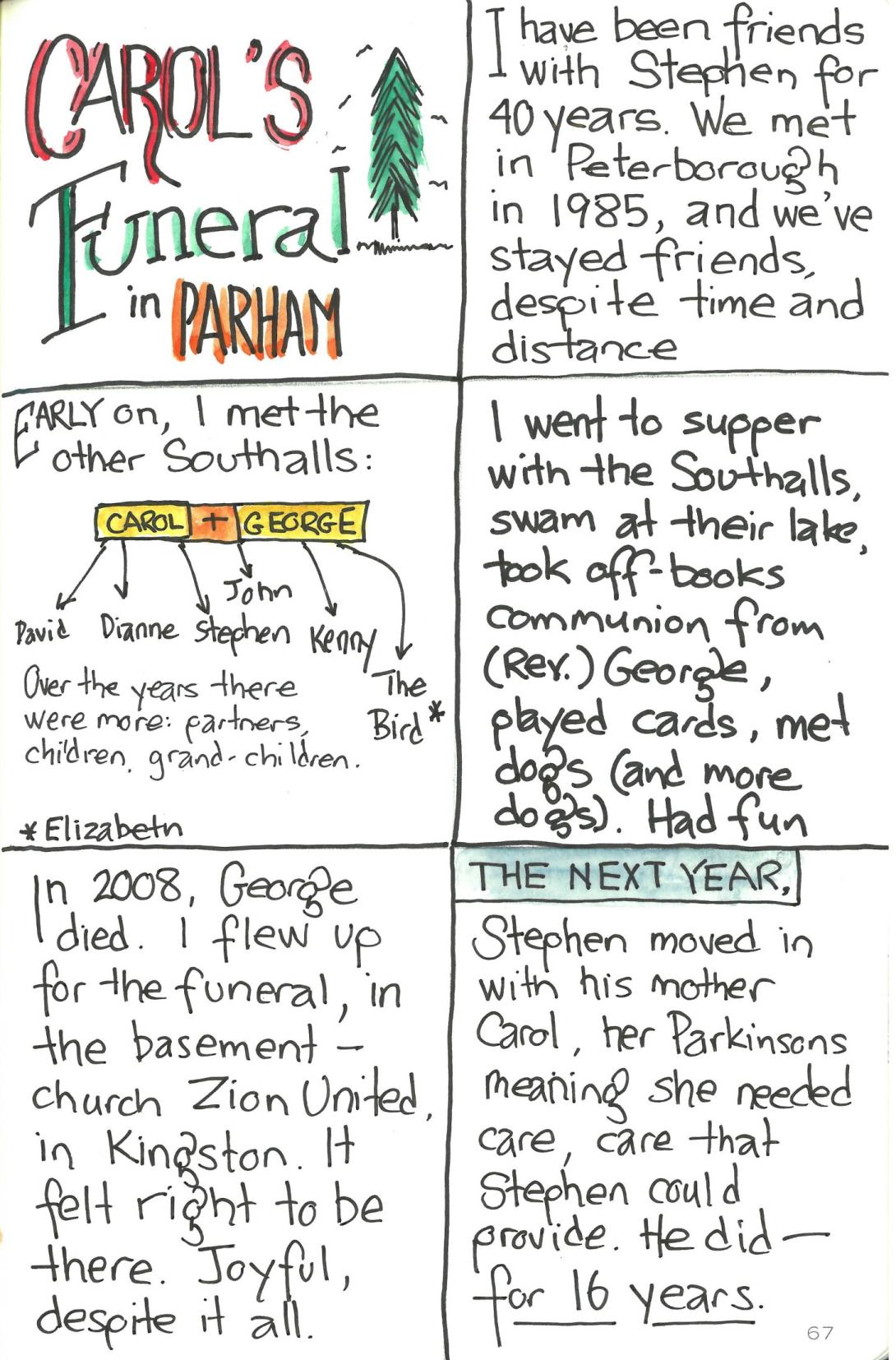

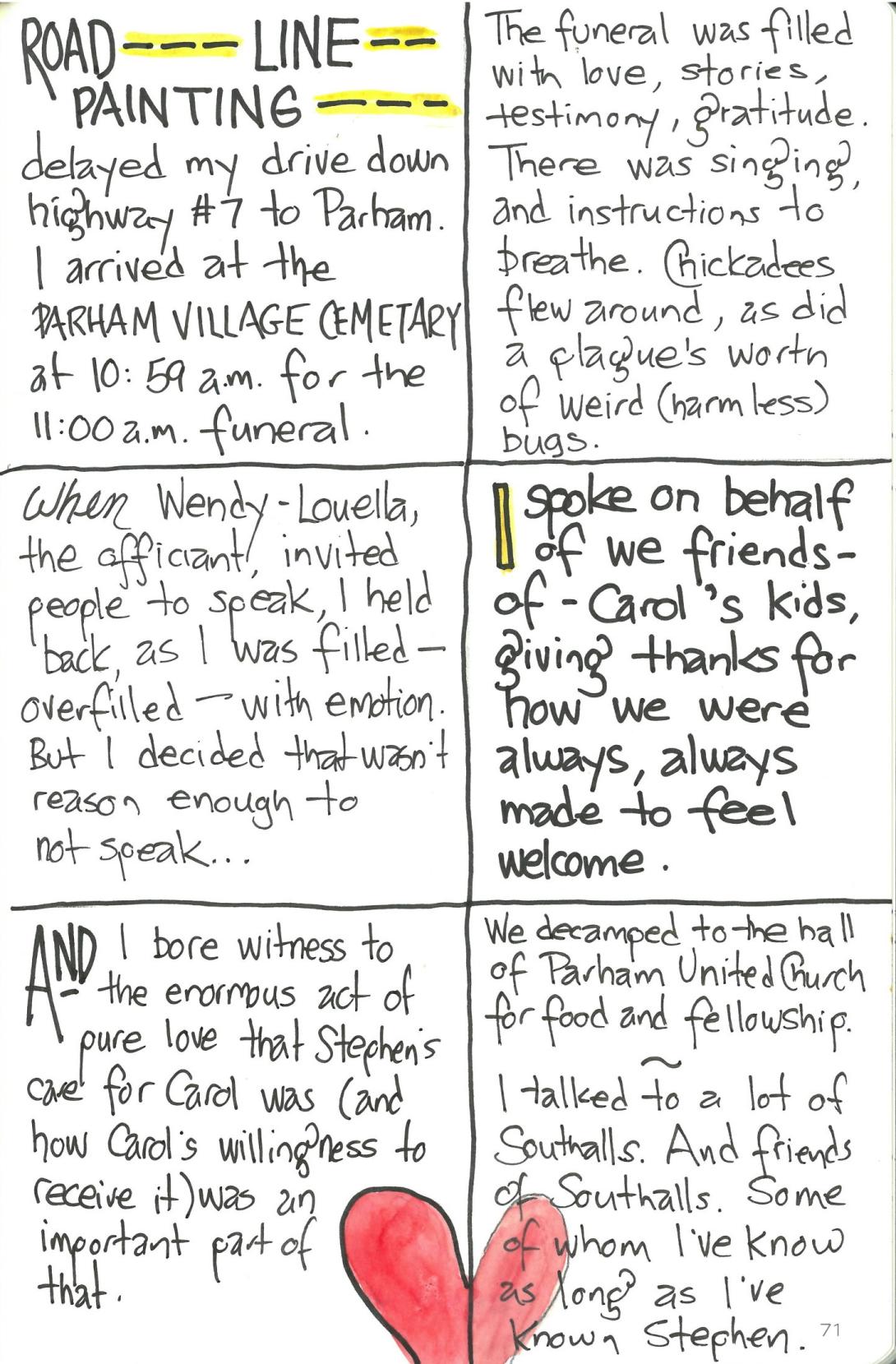
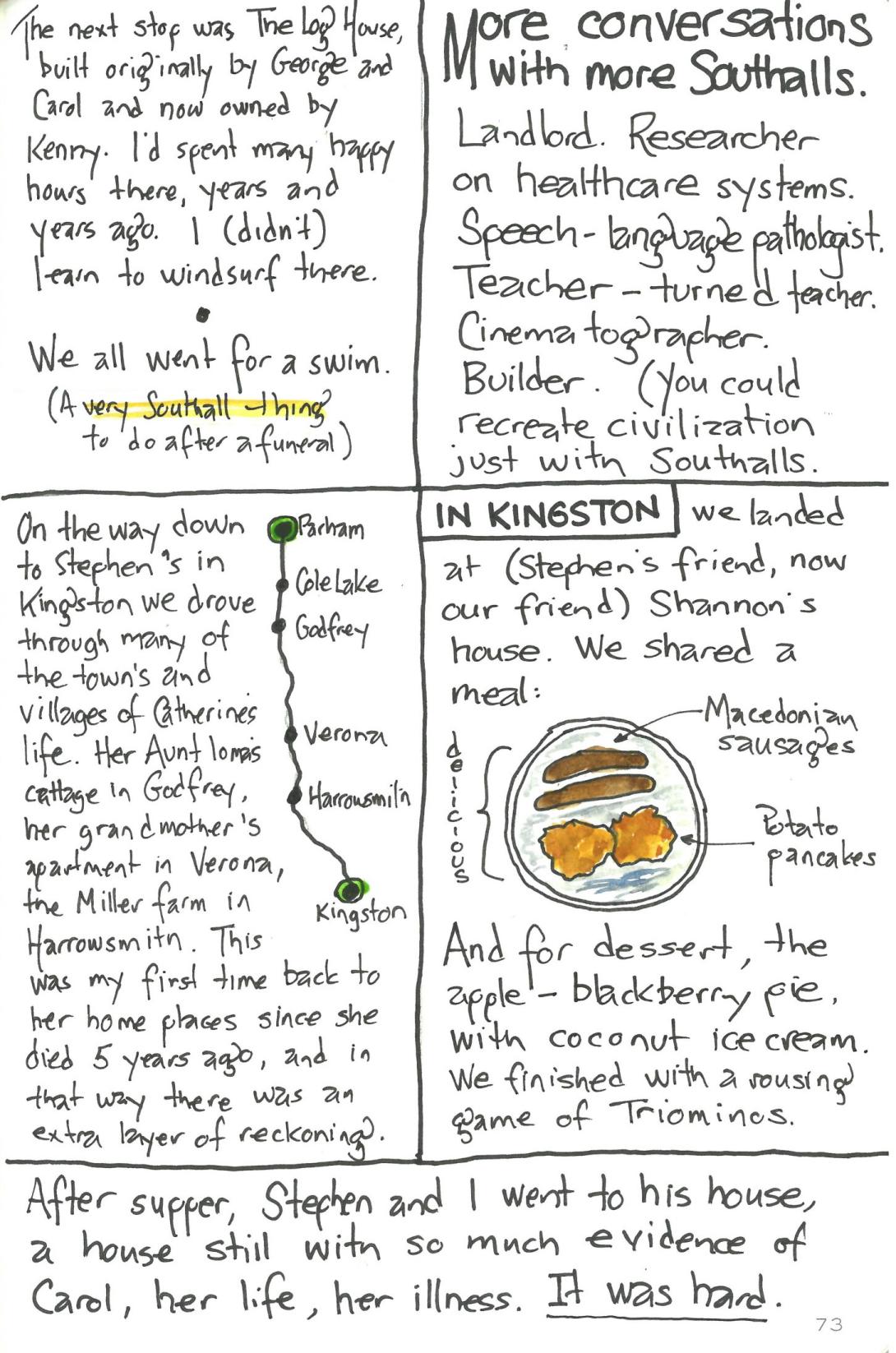
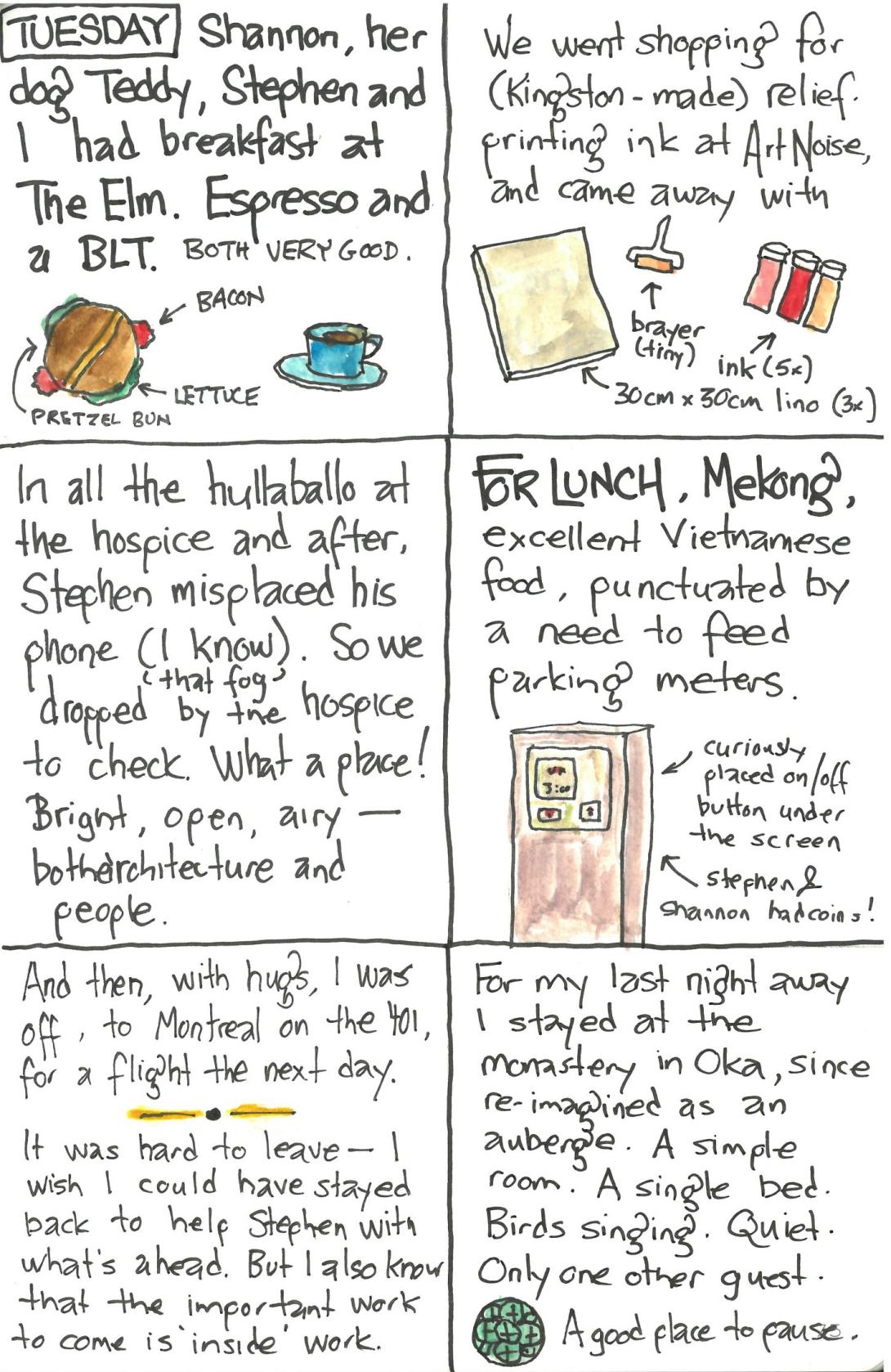

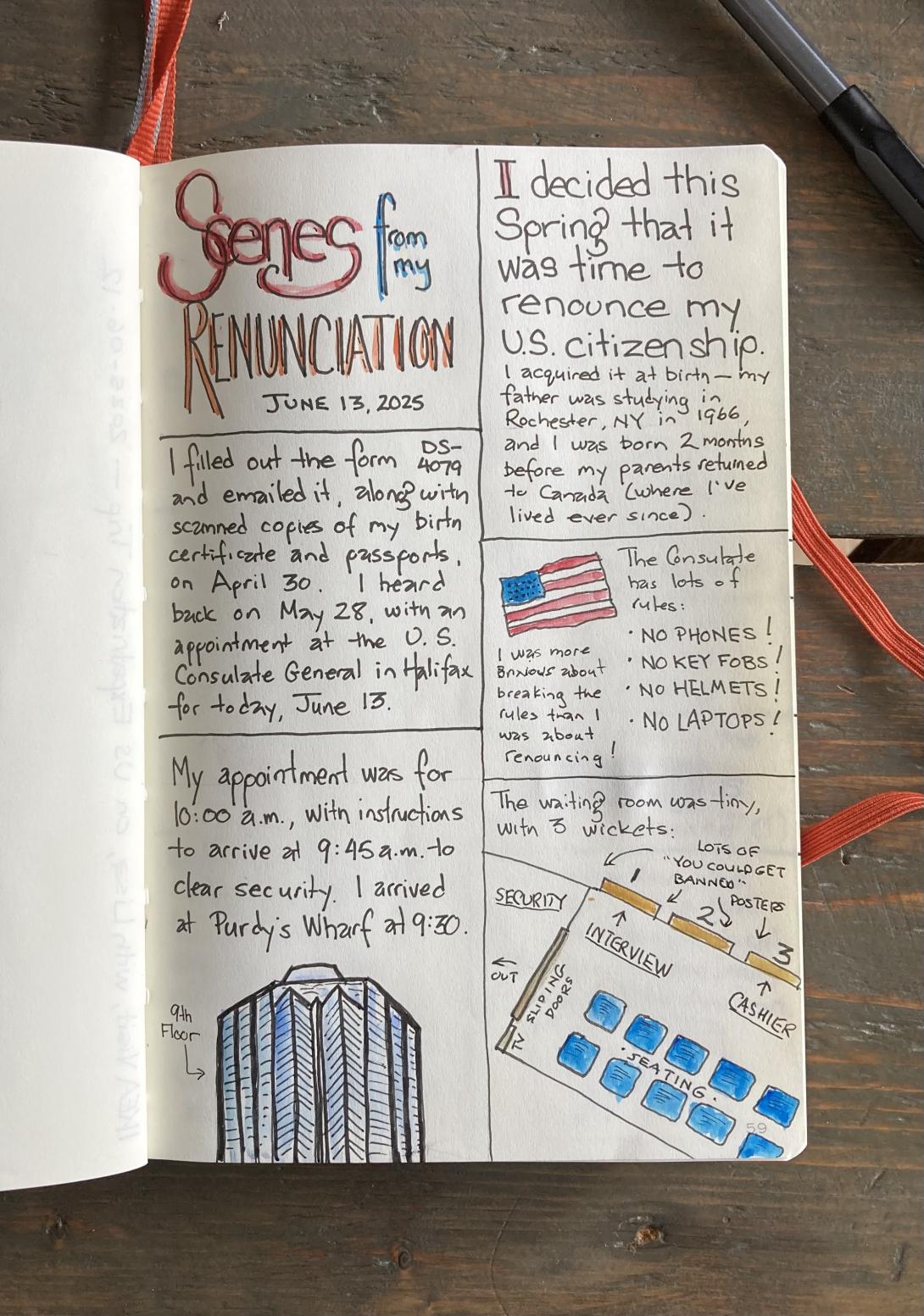
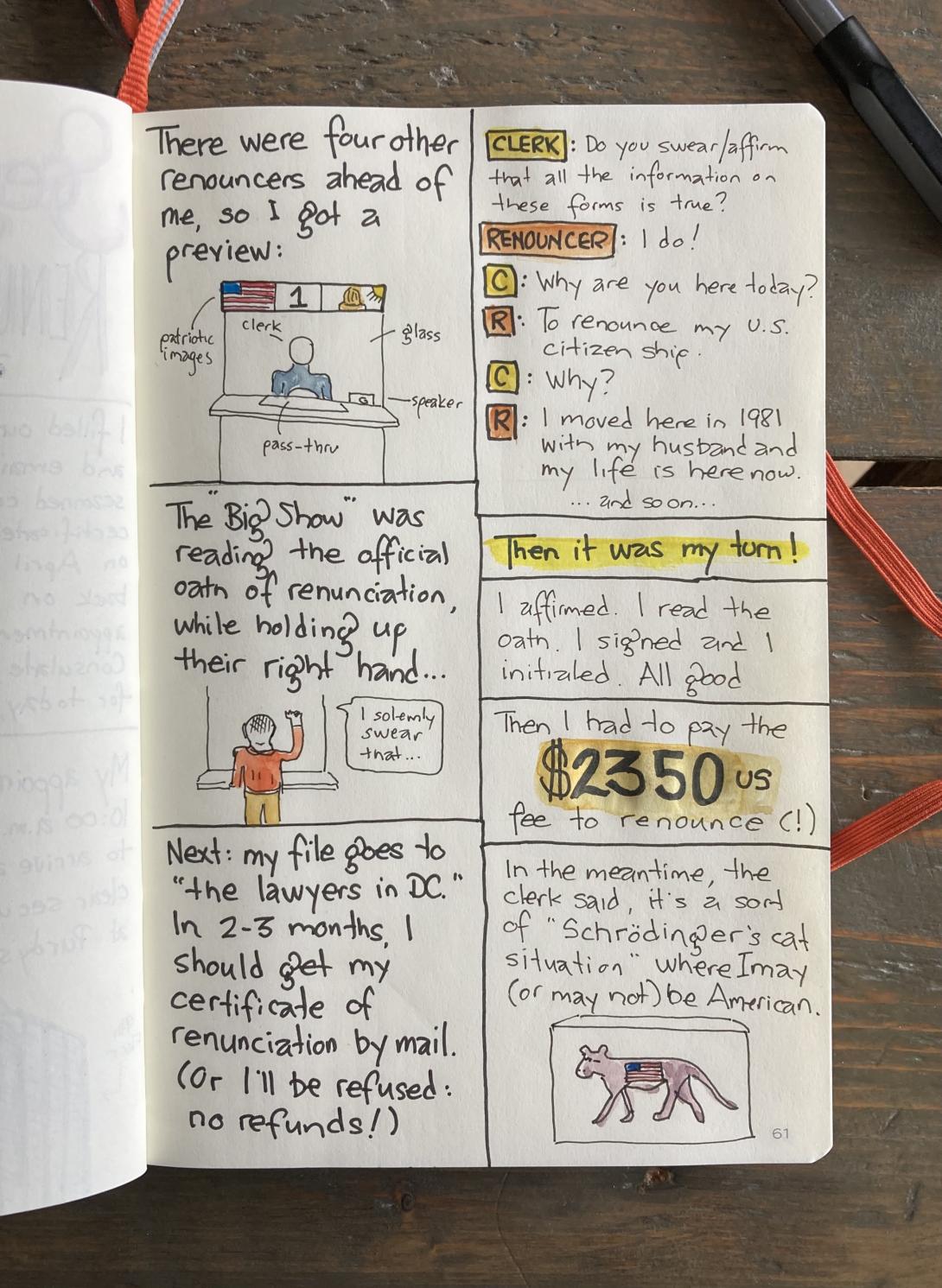
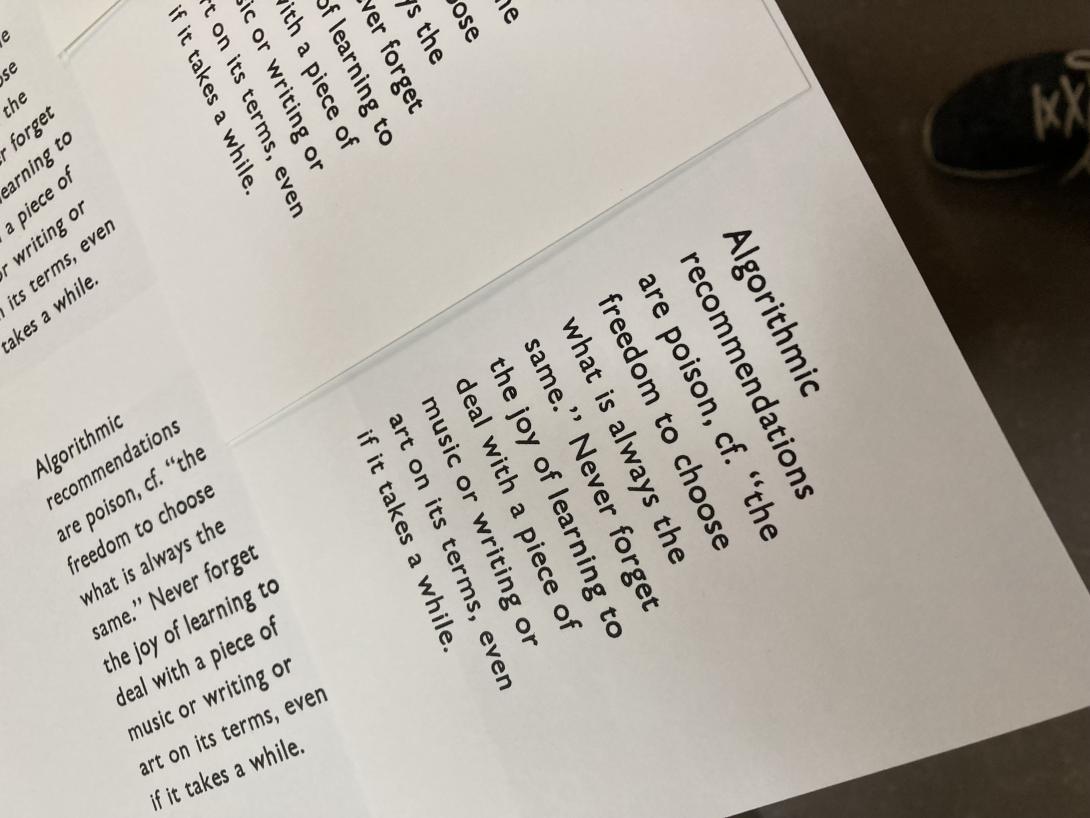
 I am
I am